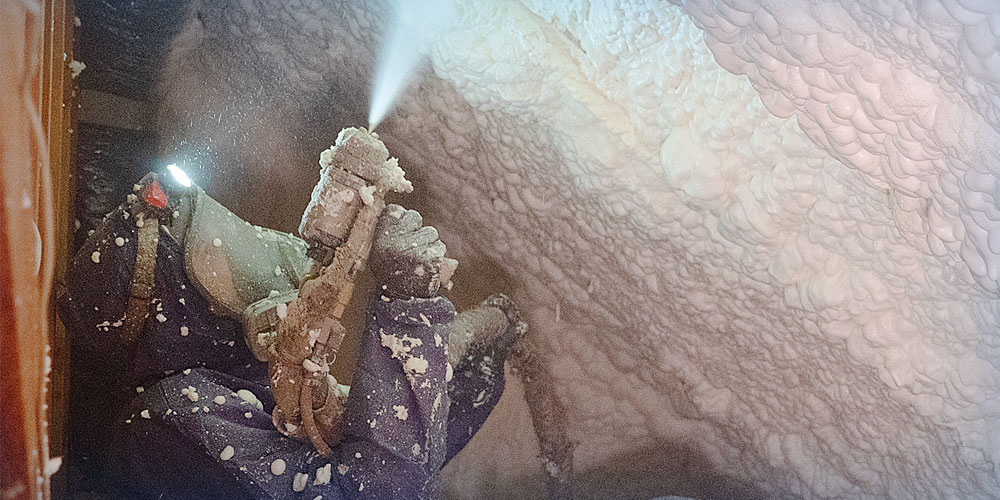Do You Need Attic Ventilation with Spray Foam Insulation?


Understanding attic ventilation is crucial for homeowners, especially when considering insulation options.
The debate often centers around whether to choose a vented or an unvented attic system, each with its specific characteristics and benefits.
Let’s delve into these two systems to help you make an informed decision for your home.
Vented Attic System: Traditional and Effective
When considering the various ways to keep your home comfortable and efficient, understanding attic ventilation is key.
A popular and time-tested method is the vented attic system.
This section will delve into the concept of a vented attic, exploring how it works, its key components, and the advantages it offers. From ridge vents to soffit and gable vents, each plays a critical role in maintaining an optimal attic environment.
We'll also examine how this traditional approach contributes to moisture control, temperature regulation, and the overall longevity of your roof. Understanding these aspects can help you decide if a vented attic system is the right choice for your home.
The Concept of a Vented Attic
A vented attic system is the traditional approach to attic ventilation.
This setup involves allowing outside air to flow freely into the attic space, which helps regulate temperature and moisture levels.
Key Components:
- Ridge Vents: These are installed along the peak of the roof, allowing hot air to escape.
- Soffit Vents: Positioned under the roof's overhang, these vents let cool air enter the attic.
- Gable Vents: Located on the gable ends of the house, these vents provide additional air circulation.
Advantages of a Vented Attic System
- Moisture Control: Helps prevent condensation and mold growth.
- Temperature Regulation: Reduces heat buildup in summer, protecting roof shingles and reducing cooling costs.
- Prolongs Roof Life: By reducing extreme temperature fluctuations.
Unvented Attic System: A Modern Approach
Shifting our focus from traditional methods, we now explore the modern and innovative approach of unvented attic systems.
This section provides a comprehensive overview of what an unvented or sealed attic entails and how it differs fundamentally from vented attic systems.
Here, insulation – typically spray foam – is applied directly to the underside of the roof deck, creating a semi-conditioned space that is both energy-efficient and versatile. We will delve into the key features of this system, such as the creation of a sealed environment and the use of spray foam insulation.
Additionally, we'll highlight the significant benefits of an unvented attic system, including enhanced energy efficiency, improved indoor air quality, and better space utilization.
Understanding the Unvented Attic
In an unvented or sealed attic system, insulation is applied directly to the underside of the roof deck. This method creates a semi-conditioned space and is often used in conjunction with spray foam insulation.
Key Features:
- Sealed Environment: No traditional vents are used, as the spray foam creates a tight seal.
- Spray Foam Insulation: Applied to the roof deck, it insulates and air-seals the attic space.
Benefits of an Unvented Attic System
- Energy Efficiency: Reduces heat transfer through the roof, lowering heating and cooling costs.
- Improved Indoor Air Quality: Less chance of pollutants and allergens entering the attic.
- Space Utilization: This makes the attic more suitable for storage or conversion to living space.
It's important to note that while there isn't a need for that traditional ventilation, that doesn't mean air shouldn't be moving in that space at all.
Once your attic becomes part of the conditioned envelope, it's important to ensure there's proper air circulation, especially if your home isn't fully air sealed. Without proper circulation, humidity can build up in the attic, leading to potential moisture issues.
In some cases, mechanicals like HVAC returns or supply vents may need to be added to help move air into the attic. This is particularly true if you're dealing with existing air leaks from outside or have poorly vented appliances like bathroom exhaust fans or stove hoods that dump warm, moist air into the attic space.
There are also humidity-sensing fans available that can be installed in the attic to kick on automatically when moisture levels rise, giving you added peace of mind and control.
At the end of the day, maintaining a healthy indoor air quality is part of being a responsible homeowner. Spray foam does a lot of heavy lifting, but circulation and ventilation strategies still play a role in keeping your attic (and your home) comfortable and dry.
Comparing Vented and Unvented Attic Systems
In the realm of attic insulation and ventilation, homeowners are often faced with a critical decision: choosing between vented and unvented attic systems.
This section aims to provide a clear and detailed comparison of these two systems, helping you understand which option might be best suited for your home.
We'll look at various factors, such as climate considerations, where vented systems might be preferable in high-humidity areas and unvented systems in colder climates. The discussion will also cover aspects of installation and maintenance, cost implications, and the suitability of each system for different types of homes, from older constructions to new builds.
By weighing these factors, you can make an informed decision that aligns with your home's specific needs and environmental conditions. This comparison is designed to give you a comprehensive view of the pros and cons of both vented and unvented attic systems.
Climate Considerations
- Vented Systems are often preferred in regions with high humidity or extreme temperatures, as they can effectively remove moisture and heat.
- Unvented Systems are ideal for controlled environments, offering better insulation and air sealing, especially in colder climates.
Installation and Maintenance
- Vented Attics require careful installation of vents and insulation to ensure proper airflow.
- Unvented Attics involve a more complex installation of spray foam but require less maintenance.
Cost Implications
- Initial Costs: Unvented systems can be more expensive initially due to the cost of spray foam insulation.
- Long-term Savings: Unvented attics can offer greater energy savings over time.
Suitability for Different Home Types
- Older Homes: Vented systems are often easier to retrofit.
- New Construction: Unvented systems are increasingly popular for their energy efficiency and space utilization benefits.
Making the Right Choice for Your Home
Deciding between a vented and unvented attic system depends on various factors, including your home's design, local climate, and specific needs.
It's advisable to consult with an attic ventilation contractor or a building science expert to determine the best option for your home.
Remember, the right attic ventilation system can significantly impact your home's energy efficiency, air quality, and overall comfort. By understanding the differences and consulting with professionals, you can ensure that your attic contributes positively to your home's performance.
Related Articles
What is Spray Foam Insulation?
About Eric Garcia
Eric brings his knowledge and training in building science, training in spray and injection foams from the manufacturers, more than eight years installing foam insulation, as well as selling and managing in the foam insulation industry. He is also BPI and Dale Carnegie certified and has taken several building science courses, including air sealing and building envelope. Eric is the Professor of Foam on our educational YouTube series Foam University. Even when Eric is off he is usually still “working” or thinking about work, but when he can get away he enjoys camping, hiking, hunting, and woodworking.


